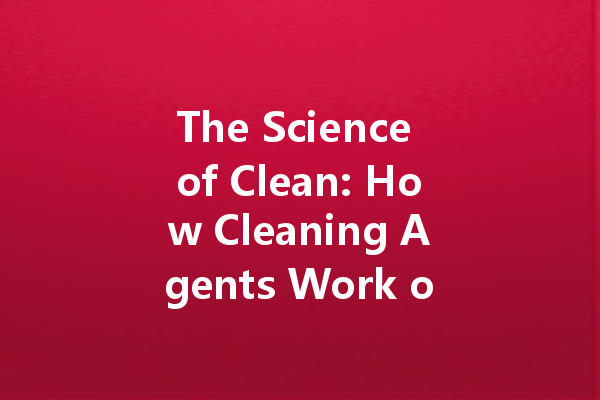Cleaning agents are ubiquitous in our daily lives, consistently working behind the scenes to keep our environments tidy and hygienic. Whether you’re scrubbing countertops, washing clothes, or disinfecting surfaces, understanding the science behind these products can improve your cleaning efficacy and safety. In this article, we will explore how cleaning agents function on various surfaces, from hard floors to delicate fabrics.
Understanding Cleaning Agents
What Are Cleaning Agents?
Cleaning agents, often referred to as detergents or cleaners, are chemical substances designed to remove dirt, stains, and impurities from surfaces. They work by breaking down soil and contaminants, making it easier for them to be washed away with water. The effectiveness of a cleaning agent largely depends on its chemical composition.
Types of Cleaning Agents
There are various types of cleaning agents, including:
How Cleaning Agents Work on Different Surfaces
Hard Surfaces
Countertops and Floors
For hard surfaces like countertops and floors, cleaning agents typically rely on surfactants to lift and remove dirt. When applied, the surfactants interact with the surface and the contaminants. As the cleaner is agitated, such as through scrubbing or mopping, the surfactants suspend the soil particles in the cleaning solution, allowing them to be easily rinsed away.
Glass and Mirrors
When it comes to glass and mirrors, cleaning agents often contain ammonia or vinegar, which effectively cut through grime and fingerprints. These agents evaporate quickly, leaving a streak-free finish that enhances visibility. The science behind this evaporation is crucial, as it ensures no residue is left behind.
Fabrics
Clothing and Textiles
Cleaning agents designed for fabrics, such as laundry detergents, employ a combination of surfactants and enzymes. Surfactants help lift stains from fibers while enzymes break down organic matter. This dual action ensures that garments emerge clean and fresh. Different washing conditions, such as temperature and agitation, can impact the effectiveness of these agents, making it essential to follow care labels.

Delicate Fabrics
For delicate fabrics, such as silk or wool, there are specialized cleaning agents that are gentler. These formulations often have lower concentrations of surfactants and avoid harsh chemicals that could damage the fibers. Understanding the specific needs of various fabrics is key to maintaining their integrity.
Specialized Surfaces
Wood
Cleaning agents formulated for wood surfaces tend to be milder than those used for hard, non-porous surfaces. They often contain oils that clean without stripping away the natural finish of the wood. This oil acts as both a cleaner and a conditioner, providing a protective layer while removing dirt and dust.
Stone and Marble
Natural stone surfaces require specific cleaning agents that do not contain acidic properties. Acids can etch and dull the surface of stones like marble and granite. Instead, pH-neutral cleaners are recommended, as they effectively remove contaminants without causing harm.
The Role of Chemistry in Cleaning
The Importance of pH Levels
The pH level of a cleaning agent greatly influences its effectiveness. Alkaline-based cleaners, with higher pH levels, are typically effective against grease and organic stains. Conversely, acidic cleaners are excellent at breaking down minerals and rust. Knowing the pH balance suitable for different cleaning tasks helps maximize cleaning efficiency.
Understanding Stain Chemistry
Different stains require different cleaning methods. For example, grease stains are best treated with solvent-based cleaners, while protein-based stains, such as blood or grass, respond well to enzyme-based cleaners. Understanding the chemical composition of stains allows users to select the most effective cleaning agent for the job.
Safety and Environmental Considerations
Safe Usage Practices
While cleaning agents are effective, they can pose risks if not used properly. It’s crucial to follow manufacturer’s instructions and use protective gear as needed. Ventilation during cleaning is also essential, especially for strong chemical cleaners that can emit harmful fumes.
Eco-Friendly Alternatives
With growing awareness of environmental issues, there is increasing demand for eco-friendly cleaning agents. These products often utilize biodegradable surfactants and fewer harsh chemicals, making them safer for both users and the planet. Many consumers are now choosing these alternatives without sacrificing cleaning power.
Conclusion
Understanding how cleaning agents work across various surfaces allows us to maximize their effectiveness while ensuring safety and environmental responsibility. From selecting the right cleaner for delicate fabrics to choosing the correct pH balance for stubborn stains, knowledgeable cleaning can turn a chore into a satisfying and effective process. By harnessing the science of clean, we can maintain healthier, more sanitary environments in our homes and workplaces.
